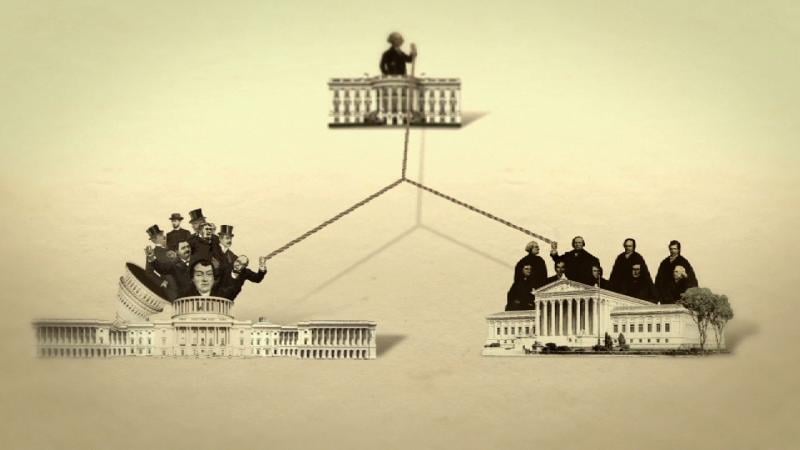In the organisation of a government, separation of powers and concentration of powers are two contrasting principles. The most significant difference between them is the distribution of power among the numerous branches of government.
Separation of powers is a political doctrine that divides a government’s powers and responsibilities between distinct, independent branches. It endeavours to prevent the concentration of power and safeguard against tyranny by ensuring that no one person or group controls the entire political system. The three principal branches are the legislative, which creates laws; the executive, which implements laws; and the judicial, which interprets laws. By segregating and balancing these powers, the system provides checks and balances in which each branch can monitor and restrict the actions of the others, thereby promoting accountability and fairness in governance.
On the other hand, the concentration of powers is a political system in which authority and control are vested in a single individual or a small group, typically resulting in autocratic or oligarchic rule. This system lacks the checks and balances of a separate system, which can lead to the abuse of power, corruption, and the violation of individual rights and liberties. The concentration of powers can take various forms, such as absolute monarchies, dictatorships, or one-party states, in which the governing entity has extensive control over the political process and little accountability to the public.
What is Separation of Powers?
Separation of powers is crucial to how a government is set up and works. Its purpose is to ensure power is shared fairly among different branches. The idea comes from Montesquieu’s political theory and is used in many democratic systems. Its goal is to keep power from getting too concentrated and to protect against tyranny.
The separation of powers divides the government into three main parts: the legislative, the executive, and the judicial. Laws are made by the legislative body, which is usually made up of a parliament, congress, or assembly. The executive branch is in charge of making sure the laws are followed. It comprises the head of state, government ministers, and administrative departments. Lastly, the judicial part has its court system and is in charge of interpreting and applying the laws.
The separation of powers is a vital part of constitutional democracies and helps make democratic systems stable and legitimate. By separating every branch and giving it its own set of powers, the system sets up checks and balances to make sure that no one group can control the whole political process. Each part can keep an eye on and limit the actions of the others. This makes government more accountable, open, and fair. This system protects the rights and freedoms of each person by keeping power from being abused. It also encourages cooperation between the branches to make decisions fairly and effectively.
What is the Concentration of Powers?
The concentration of powers is a political system in which power and control are centralised in the hands of one person or a small group. This often leads to autocratic or oligarchic rule. This idea differs from the separation of powers, which tries to spread power among various branches of the government so that power doesn’t get too concentrated and tyranny doesn’t arise.
In a system with concentrated power, the legislative, executive, and judicial bodies may all be run by the same person or group, or the lines between them may be blurry. If there aren’t any checks and balances, it’s easy for the person or group in charge to run the government and consolidate their power. This concentration of power often leads to people abusing their power, being selfish, and stepping on people’s rights and freedoms.
The concentration of power can look like absolute monarchies, dictatorships, or one-party states. In these systems, the group in charge has a lot of power over the government and its institutions and may not have to answer to anyone. Concentrated systems are more likely to be unstable. They may lack the legitimacy and responsiveness needed for good governance because they don’t promote the same levels of transparency, accountability, and justice as systems with separated powers.
Difference Between Separation of Powers and Concentration of Powers
The distribution of authority within a government is at the heart of the debate between separation of powers and concentration of powers. To prevent the accumulation of power and safeguard against tyranny, a government should separate its functions into three separate and distinct branches: the legislature, the executive, and the judiciary. It creates a system of checks and balances that encourages transparency and equity. But when power is concentrated, autocratic or oligarchical rule is more likely to result, whether in the hands of one person or a few. The lack of safeguards in this system increases the likelihood of tyranny, corruption, and the restriction of fundamental freedoms. We’ve compared the two systems, with their key differences highlighted below.
Distribution of Authority
In a government with a separation of powers, power is delegated to several branches. In contrast, in a government with a concentration of powers, power is concentrated in the hands of a few.
Checks and Balances
The concentration of power, in contrast to the separation of powers, makes it simpler for the governing individual or group to misuse their authority due to the absence of measures to promote accountability, transparency, and fairness.
Protection Against Tyranny
The goal of the separation of powers is to prevent tyranny by ensuring that no single entity dominates the political process. On the other hand, the concentration of powers can make it easier for autocratic or oligarchic rule, which frequently results in authoritarian governments.
Individual Rights and Liberties
When checks and balances are in place, a system of separation of powers protects people’s freedoms and rights from being abused. In contrast, a system of concentration of power is more likely to violate those rights.
Political Stability and Legitimacy
While the concentration of power can lead to instability and a lack of legitimacy due to a lack of accountability and public participation, the separation of powers contributes to the stability and legitimacy of democratic institutions by encouraging collaboration and balanced decision-making.
Forms of Government
In contrast to the separation of powers that characterises constitutional democracies, the concentration of powers is characteristic of regimes like absolute monarchs, dictatorships, and one-party states.






